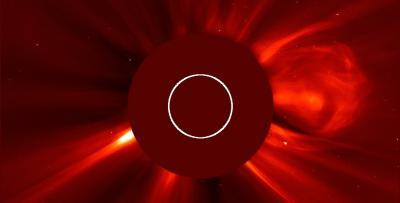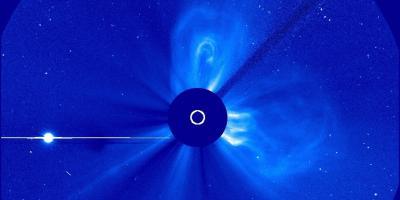A coronal mass ejection (CME) is when our sun sends billions of tons of solar particles into space. A CME can affect electronic systems in satellites and NASA recently saw three.
First CME: April 20, 2013, at 2:54 a.m. EDT, a CME left the sun at 500 miles per second (1). It may pass by NASA's MESSENGER (MErcury Surface, Space ENvironment, GEochemistry, and Ranging), which investigates the planet Mercury, and STEREO-A (Solar TErrestrial RElations Observatory) satellites but no particle radiation is associated with this event, which is what would normally concern operators of interplanetary spacecraft. Particles can trip computer electronics on board and NASA operators can put spacecraft into safe mode to protect the instruments from the solar material.
Second CME: The same region of the sun erupted with another coronal mass ejection (CME) at 3:54 a.m. on April 21, 2013. Experimental NASA research models show the CME left the sun at speeds of 550 miles per second and that the CME will also pass by NASA's MESSENGER. The flank of the CME may graze STEREO-A and there may be some particle radiation associated with this event so operators might put the spacecraft into safe mode.

The third coronal mass ejection (CME) in two days erupted off the sun in the direction of Mercury on April 21, 2013, at 12:39 p.m. EDT. This image of the Coronal Mass Ejection (CME), shown shooting off the left side of the image, was capture by the joint ESA and NASA Solar Heliospheric Observatory (SOHO). The sun is blocked in this image so its brightness doesn't obscure the solar atmosphere, the corona. Credit: : ESA&NASA/SOHO
Third CME: At 12:39 p.m. EDT on April 21, 2013, another coronal mass ejection (CME) erupted from the sun, headed toward Mercury and NASA's MESSENGER spacecraft. The CME left the sun at 625 miles per second and that it will catch up to the second CME before the combined CMEs pass MESSENGER. There is also chance that the combined CMEs will give a glancing blow to STEREO-A.

This image of a coronal mass ejection (CME) was captured at 7:30 a.m. EDT on April 20, 2013. The CME is headed in the direction of Mercury. The large bright spot on the left is Venus. Credit: ESA&NASA/SOHO
(1) Since the Earth is 92,960,000 miles from the Sun, if the CMEs were coming here at 600 miles per second it would take a few days to reach us.





Comments